Adding Optics

Yes, I know this is supposed to be a test of the Chaser .22 with the rifle barrel but there has been a lot of talk about the sights on the Chaser, such as changing the rear sight for one with more adjustments. With the 11mm rail running the entire length of the receiver this opens the door for several possibilities to upgrade the Chaser. One suggestion has been the Air Venturi Williams notch rear sight. It will fit, but whether it will be comparable with the very tall ramped front sight on the Chaser is another question. This is something we will have to delve into at another time, as well as other options for adjustable sights. But today, to put one possible upgrade for the pistol or rifle version to bed, I want to address the very affordable option of adding optics.
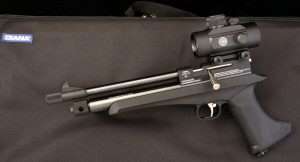
Vision Quest
Optics are hot; more and more handgun manufacturers are introducing semi-auto pistols with dovetailed mounting plates built into the slide, and some models come with a reflex sight as a standard feature, like the Smith & Wesson Pro Series C.O.R.E. (Competition Optics Ready Equipment) M&P40, several variations of Sig Sauer pistols, including the P320 RX, and Springfield Armory’s XD(M) .45 O.S.P. (Optical Sight Pistol). It may be only a matter of time until a similar approach is taken by an airgun manufacturer with a CO2 powered semi-auto. Red dot sights have been around for decades, reflex sights nearly as long, and the technology to build them more efficiently has brought the cost way down. Reflex sights for air pistols are very affordable, but you have to be able to mount them. Diana eliminated that problem by incorporating an 11mm rail across the top of the Chaser’s receiver. All you need to do is remove the rear sight and mount an optic with an 11mm base (or a base adjustable to 11mm). You can also mount an 11mm to Weaver rail to use other scopes and reflex sights. Options abound.

For this article I have selected a Hawke Sport Optics 1x30mm red/green dot scope with a 9-11mm rail mount. This is a medium-priced scope with an anodized aluminum chassis, 25 layer multi-coated optics, 5 MOA dot, and 5 brightness settings in red or green. The Hawke has flip up protective covers for the lenses, which can be a little annoying depending upon the gun it’s mounted to, so the covers on the Hawke are hinged to removable shrouds that fit over the lens barrels. This makes them easy to remove for mounting the scope on a pistol, where the flip up lens covers can be annoying. The Hawke Model 12120 weighs only 5.7 ounces and runs on a single CR 2032 battery. It has a suggested retail of $60 and yes that puts it at almost the same price of the Chaser pistol, but doubling the investment with an optic is money well spent.
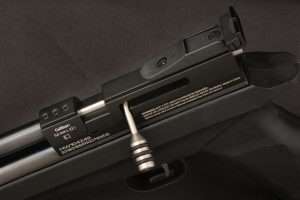
More bullseye hits?
The first thing you need to do is remove the rear sight from the Chaser’s receiver. This requires unscrewing the Philips head screw at the front of the mount, then removing the elevation screw which is a flathead, carefully lifting the rear sight up about half way until you see the adjustment spring underneath. Making sure not to let the spring pop out (springs go all kinds of places), remove it as you raise the rear sight and set it aside. Underneath is a second Phillips head screw to remove and then the sight comes off the receiver.

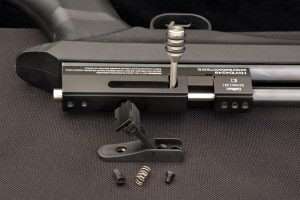
The Hawke has two sides to the locking clamps 9mm and 11mm. I had to loosen the locking screws and rotate the clamps to fit the 11mm rail, and then slide the sight onto the receiver, positioning it as far to the rear edge as possible. First thoughts are, “Will the bolt handle clear the bottom of the locking screws?” Yes. The next question is, “Will the Stormrider magazine still fit?” And the answer there is unfortunately, no. It won’t clear the barrel of the Hawke scope. With the scope mounted, the Chaser is a single shot target pistol.

With the Chaser needing sight adjustments for each brand of pellet, at least with the adjustable rear sight, I decided to limit my Hawke optics test to one brand only and shoot the Meisterkugeln 14 gr. wadcutters. We have already established average velocity at 445 fps and shooting at 10 meters with the Hawke scope set on the green dot, I began making sight adjustments with my own sighting target. It took only six shots to zero in and of those six three were almost overlapping. Switching to a 10 meter target my best five rounds went into the bullseye, 10 and 9 rings, with four of five overlapping and the fifth just a hair higher, for a spread of 0.625 inches.
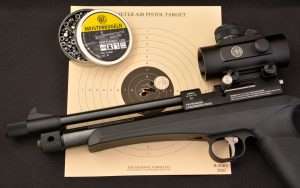
I ran half a dozen other targets with similar results so I was pretty satisfied with the Hawke setup on the Chaser. One thing about target shooting with the .22 Diana, it goes through CO2 pretty fast; I would estimate 25 to 30 shots before you begin to see a drop in point of impact. And that brings me to my last target of the day. Running low on air and hitting a little below the bullseye, I was still getting tight groups. My last target (pictured) has 10 consecutive rounds at 0.5 inches.
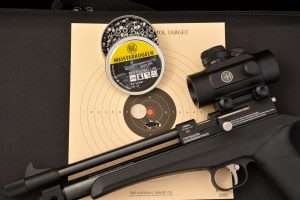
The .22 pistol with the Hawke scope has a total MSRP of $146 and sells for around $125 through Pyramyd AIR. I don’t think you can get a better combination for shooting fun, target accuracy, and value for the dollar. The Chaser and the Hawke is a pretty good pair.

When is a pistol not a pistol? When it is a rifle. Rifle to pistol conversions are not uncommon, particularly in AR-15 and AK-47 based platforms that have been reworked from long range target rifles, to SBRs (short barreled rifles) and to pistols without stocks, with folding stocks, braces, or collapsible stocks. Depending upon how the rifle’s platform, barrel and stock are reconfigured can make it anything from a civilian legal carbine to a Class III firearm, and yet, at their core, one and the same. Airguns do not have such restrictions, and the Diana Chaser actually takes a reverse approach by converting the pistol into a rifle with a 17.7 inch rifled steel barrel chambered in either .177 or .22 caliber (4.5mm or 5.5mm). As a pistol and pistol carbine with the addition of the Chaser stock sold in the rifle/pistol kit, the Diana model has already proven itself a very capable CO2 powered single or multi-shot entry-level target pistol. With the rifle/pistol kit you get to take the Chaser to the next level, 10 meter target rifle.

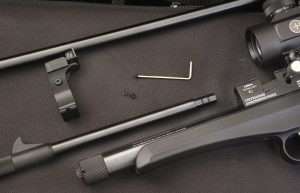
Making the Barrel Swap
Diana has made this about as easy as possible, involving a few screws, a barrel change and an added barrel band. It’s interesting that the instruction book shows the Chaser coming as an assembled rifle that is to be converted into the pistol, whereas the gun comes as a pistol to be converted into a rifle, (at least in the U.S. market versions, which also have the silencer on the rifle barrel permanently affixed). Nevertheless the process of turning the Chaser pistol into the rifle is the same in reverse. There are two small hex head tools in a plastic bag that comes with the rifle/pistol kit (the same bag I stored the rear sight parts in for Part 6); one hex head wrench is used to remove the three set screws that hold the pistol barrel to the receiver, the other to tighten the set screw on the barrel band. The entire conversion is done with an empty chamber, unlocked bolt and no CO2 loaded.



The three barrel locking set screws on top of the receiver are removed in order, noting that the middle screw is slightly longer and has to go back in the center hole. Pull the pistol barrel out and set it aside. The barrel band is slipped over the barrel from the breech end and moved as forward beyond where the barrel and CO2 chamber align (it is the last piece to be positioned and tightened down). Slip the breech end of the rifle barrel into the receiver noting that there is a registration hole in the top of the barrel that matches up with the center screw hole in the receiver. Once this is in position, insert the longer center screw and tighten it down, then follow with the remaining set screws. They should all be turned flush with the top of the receiver.
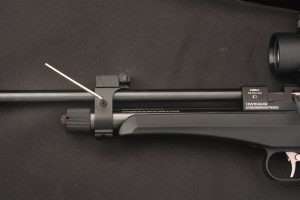
Slide the barrel band over the CO2 chamber, centering it between the cap and the forend, and then tighten it down with the second hex head tool supplied with the Chaser kit. Mount the shoulder stock and you have a Chaser rifle. Since I already had the Hawke scope mounted to the receiver I decided to leave it in place and begin the rifle test with the scope.

A .22 Air Rifle at 10 Meters
First, let’s address the degree of rearward movement necessary to allow the Stromrider pellet magazine to fit with the Hawke scope mounted. It turned out to be less than I anticipated, just 0.125 inches, not awkward looking at all, and with the shoulder stock mounted just enough clearance to easily slide the pellet magazine in and out. So, while there are other optics alternatives, different scopes with adjustable mounts, 11mm to Weaver rail adapters, etc; unless you want to raise the optic to co-witness the adjustable sights, (not a bad idea if you are using the .22 Chaser in the field for small game hunting), the Hawke works just fine, and allows you to have an ideal alignment with the shooter’s line of vision being mounted directly to the rail. Combining the Hawke 1x30mm red/green dot scope with the .22 Chaser rifle/pistol kit is also a very affordable package.


Velocity with the 17.7 inch rifled barrel should see a substantial increase over the pistol barrel. The Diana factory specs for the rifle barrel are a maximum of 500 fps in .22 caliber, (560 fps in .177). For the rifle I am using the same four pellets as the pistol test. The Meisterkugeln 14 gr. lead wadcutters cleared the ProChrono screens at a high of 529 fps, a low of 525 fps and an average of 526 fps. This compares with an average velocity of 445 fps with the .22 pistol barrel. One other big difference is the silencer (noise suppressor) on the 17.7 inch barrel. The pistol is medium loud; the rifle barrel reduces the dB level to low, with the majority of sound coming from internal mechanisms, very much the types of mechanical sounds you get from a silenced semi-auto handgun or rifle. The Diana noise suppressed rifle barrel is very effective.


On to the H&N Sport 13.73 gr. lead wadcutters which clocked a high of 537 fps, a low of 527 fps and an average of 528 fps for five shots. The H&N fired from the pistol averaged 449 fps. Now we’re getting into the light weight rounds, the 11.9 gr. RWS Hobby Sport Line wadcutters. These averaged 469 fps from the .22 Chaser pistol so I am expecting a mid 500 fps average from the rifle barrel and I did not come away disappointed. Highest velocity with the H&N was 552 fps, a low of 548 fps and an average of 549 fps, well above the factory rated 500 fps for the .22 model.
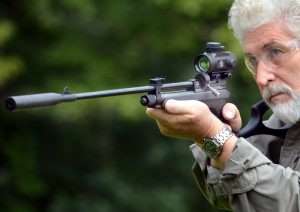
Last up, the Sig Sauer Crux Ballistic Alloy 10.3 gr. domed pellets which delivered the highest velocity with the pistol barrel of 502 fps. Traveling down the 17.7 inch Diana Chaser .22 barrel the Crux domed pellets did not clock as fast as the RWS Hobby wadcutters with a high of 544 fps, a low of 538 fps and an average velocity of 541 fps.
10 Meter Target
I chose the highest velocity RWS Hobby Sport Line wadcutters for the 50 foot accuracy test with the Hawke scope, and H&N for the 10 meter test. My best 5-shot target at 10 meters measured 0.437 inches fired offhand using the Hawke scope. That’s exactly what my best group was shooting the Chaser .22 as a pistol carbine.

One solitary issue arose when I removed the Hawke and shot the Chaser rifle at 10 meters with the rifle barrel sights. I was not able to correct windage on the 17.7 inch barrel’s rear sight sufficiently to move my groups left. I finally shot targets and let the windage go, hitting right of center. I shot the final test with Meisterkugeln and put a best five rounds into 0.625 inches (center-to-center), which is actually not as good as I did with the pistol barrel and shoulder stock. I’ve always been a better pistol shot than a rifleman so I’m not totally surprised by my slightly wider groups, but more so by the windage adjustment. Could be just the rear rifle sight on this gun, but in the overall scheme of things, I wouldn’t shoot the rifle barrel Chaser without a scope in the first place, so it’s not a deal breaker for me.

Pushing the rifle barrel out to 50 feet with the Hawke, and using a Shoot-N-C target and the RWS Hobby lead wadcutters, I put a total of 10 shots into 2.375 inches, which included an awful flyer to the right that expanded my 10 shots from 1.81 inches (9 out of 10). Out of nine there was one 4-shot group that measured 0.625 inches, and one overlapping pair. Not a great target but still a pretty small group fired offhand from 50 feet. Tin cans wouldn’t have a chance!

Final Thoughts on the Diana Chaser
I’ve managed more shooting time with the Chaser than any other air pistol this year, and have had more variations to shoot with one basic kit gun than any other CO2 pistol, period. For an investment of only $175 (the Chaser rifle/pistol kit and Hawke scope or $125 for the Chaser pistol and Hawke scope), plus CO2 and pellets (and another $20 for the pellet magazine if you want a bolt action repeater), I have to give the Diana Chaser my award as the “Most gun for the money” this year, and probably for a lot of years to come. Even as a .177 pellet model it is impossible to beat this combo. And if you want a.22, the Chaser doubles down.
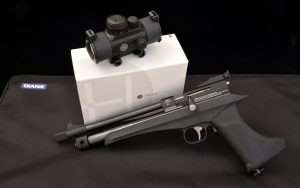
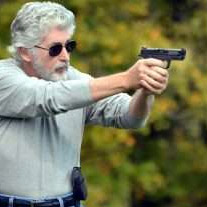
The optics confirm that TheChaser is target accurate. Very impressive and confirms the pistol’s Best Buy status. I hope Pyramid bundles the stock with a pistol, and wouldn’t be a bad idea to offer a premium sighted target , and optic package as well.
The CenterPoint 1×25 Multi-TAC Quick Aim Sight has mounting rings that are not attached to the scope tube. The supplied rings could be replaced with alternate rings that provide enough elevation to allow the Stormrider magazine to be used.
/product/centerpoint-1x25mm-multi-tac-quick-aim-sight-weaver-style-rings?a=3647
These UTG 11 mm Dovetail to Weaver mount adapters work very well. They insert right into the Weaver mount on the scope ring so that you can then attach to a dovetail.
/product/utg-11mm-3-8-dovetail-to-weaver-adapter-2pcs?a=4148
I’m posting the following comment a second time because the system is holding up my first comment with links saying, “Your comment is awaiting moderation.” I don’t know why it’s awaiting moderation. The links are to Pyramyd AIR product listings. Here’s my comments without links.
The CenterPoint 1×25 Multi-TAC Quick Aim Sight has mounting rings that are not attached to the scope tube. The supplied rings could be replaced with alternate rings that provide enough elevation to allow the Stormrider magazine to be used.
UTG has 11 mm Dovetail to Weaver mount adapters that insert right into the Weaver mount on the scope ring so that you can then attach to a dovetail. These adapters are available in the Pyramyd AIR Accessories.
The insert adapters should work well. I use them on two different guns. They have not moved on my HW50. The adapters are on Tru glo reflex sights.
With regards to the Hawke Sight, It looks like one could drill and tap the rear screw forward a little, thus moving the sight back to allow the magazine to fit while maintaining a good clamp?
Hi, attached is the picture of the adjusted Hawke mount. Turns out the mount uses a stud so just drilling a new hole is required. Need to make sure the new hole is straight. I found the mounting clips didn’t fit very well and requiring some filing. Very happy with the accuracy. Hmmm need resize photo to meet upload limits, will do later.
Here is the picture of the modifies Hawk mount.